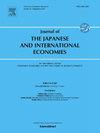Optimal monetary policy in a liquidity trap: Evaluations for Japan’s monetary policy
IF 3.1
3区 经济学
Q1 ECONOMICS
Journal of the Japanese and International Economies
Pub Date : 2025-03-07
DOI:10.1016/j.jjie.2025.101361
引用次数: 0
Abstract
This paper shows (1) a positive analysis demonstrating that recent high inflation rates can be explained by the Bank of Japan (BOJ)’s monetary policy for the COVID-19 pandemic period, “Inflation-Overshooting Commitment,” and (2) a normative analysis showing that the BOJ’s inflation-overshooting commitment aligns with the optimal monetary policy in a liquidity trap within a new Keynesian model with inflation persistence. In detail, we calibrate a hybrid new Keynesian model by Japanese parameters and show optimal monetary policy under commitment. Optimal monetary policy prolongs the zero interest rate until the second quarter of 2024 even after inflation rates overshoot 2 percent. Similarly, the BOJ continues the zero interest rate policy until the second quarter of 2024. The current average inflation rates from 2023Q4 to 2024Q3 reach 2.6 percent and 2.5 percent in the data and the model, respectively.
Our conclusion holds for a variety of situations with Japanese parameters, such as a low output gap response to the real interest rate, discounted IS curve, alternative inflation persistences, interest-rate smoothing for the policy rate, an alternative specification of the Phillips curve, inflation target, and low/high anchored inflation expectations and natural interest rates.
流动性陷阱中的最优货币政策:对日本货币政策的评价
本文展示了(1)一项实证分析,表明最近的高通胀率可以用日本央行(BOJ)在COVID-19大流行期间的货币政策“通胀超调承诺”来解释;(2)一项规范分析,表明日本央行的通胀超调承诺与具有通胀持续性的新凯恩斯模型中流动性陷阱中的最优货币政策一致。详细地说,我们用日本参数校准了一个混合的新凯恩斯模型,并展示了承诺下的最优货币政策。最优货币政策将零利率延长至2024年第二季度,即使通胀率超过2%。同样,日本央行将继续实行零利率政策,直到2024年第二季度。从数据和模型来看,目前2023Q4到2024Q3的平均通胀率分别为2.6%和2.5%。我们的结论适用于具有日本参数的各种情况,例如对实际利率的低产出缺口响应、折现的IS曲线、替代通胀持续性、政策利率的利率平滑、菲利普斯曲线的替代规范、通胀目标、低/高锚定通胀预期和自然利率。
本文章由计算机程序翻译,如有差异,请以英文原文为准。
求助全文
约1分钟内获得全文
求助全文
来源期刊
CiteScore
5.10
自引率
6.90%
发文量
36
期刊介绍:
The Journal of the Japanese and International Economies publishes original reports of research devoted to academic analyses of the Japanese economy and its interdependence on other national economies. The Journal also features articles that present related theoretical, empirical, and comparative analyses with their policy implications. Book reviews are also published.

 求助内容:
求助内容: 应助结果提醒方式:
应助结果提醒方式:


